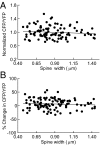Experience-dependent regulation of CaMKII activity within single visual cortex synapses in vivo
- PMID: 22160721
- PMCID: PMC3248554
- DOI: 10.1073/pnas.1108261109
Experience-dependent regulation of CaMKII activity within single visual cortex synapses in vivo
Abstract
Unbalanced visual input during development induces persistent alterations in the function and structure of visual cortical neurons. The molecular mechanisms that drive activity-dependent changes await direct visualization of underlying signals at individual synapses in vivo. By using a genetically engineered Förster resonance energy transfer (FRET) probe for the detection of CaMKII activity, and two-photon imaging of single synapses within identified functional domains, we have revealed unexpected and differential mechanisms in specific subsets of synapses in vivo. Brief monocular deprivation leads to activation of CaMKII in most synapses of layer 2/3 pyramidal cells within deprived eye domains, despite reduced visual drive, but not in nondeprived eye domains. Synapses that are eliminated in deprived eye domains have low basal CaMKII activity, implying a protective role for activated CaMKII against synapse elimination.
Conflict of interest statement
The authors declare no conflict of interest.
Figures





References
-
- Mioche L, Singer W. Chronic recordings from single sites of kitten striate cortex during experience-dependent modifications of receptive-field properties. J Neurophysiol. 1989;62:185–197. - PubMed
-
- Freeman RD, Olson C. Brief periods of monocular deprivation in kittens: Effects of delay prior to physiological study. J Neurophysiol. 1982;47:139–150. - PubMed
-
- Hensch TK. Critical period plasticity in local cortical circuits. Nat Rev Neurosci. 2005;6:877–888. - PubMed
Publication types
MeSH terms
Substances
Grants and funding
LinkOut - more resources
Full Text Sources

